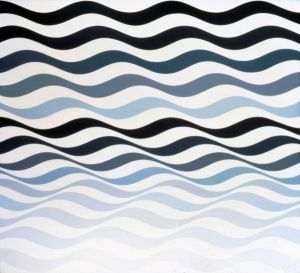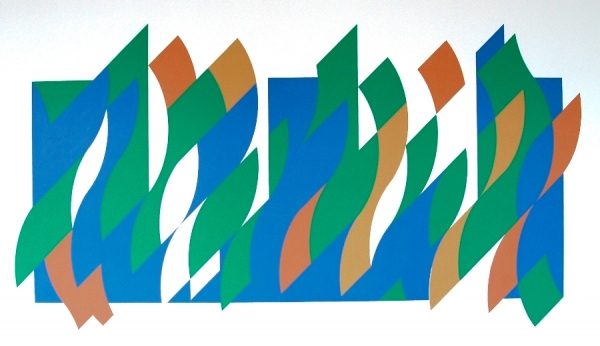Bridget Riley: Paintings and Related Work, National Gallery | reviews, news & interviews
Bridget Riley: Paintings and Related Work, National Gallery
Bridget Riley: Paintings and Related Work, National Gallery
Looking again and again: Riley repays a visit
Well, we all make mistakes. Or, in my case, we (I mean “I”) sometimes just fail to look. This new, small but perfectly formed exhibition of Bridget Riley’s work in the National Gallery’s Sunley Rooms follows the pattern that the gallery has developed over the years, with a single artist entering into a conversation with the great art of the past. Riley’s conversation is gripping, and one of the things it says (to me) is, “Shame on you for not looking.”
 Shame on me indeed, for I have for far too long looked but not seen, tagging Riley as an Op Art operator, shrugging her off as “very good, but not my thing”. Well, she should be everybody’s thing, and I am suitably chastened. In the first of the show's two rooms, an early piece from 1965, Arrest 3 (pictured right) is concerned with the things of the 1960s – with showing the surface of the work, with abstraction – but it is far more nuanced than that description makes it sound, and on the wall opposite, one sees why, for there hangs Mantegna’s The Introduction of the Cult of Cybele at Rome, where Mantegna, nearly 500 years earlier, in this masterpiece of grisaille, focuses on the same concerns that Riley has picked up and begun to explore: picture surface, pictorial space, and the tension between paint and what is painted.
Shame on me indeed, for I have for far too long looked but not seen, tagging Riley as an Op Art operator, shrugging her off as “very good, but not my thing”. Well, she should be everybody’s thing, and I am suitably chastened. In the first of the show's two rooms, an early piece from 1965, Arrest 3 (pictured right) is concerned with the things of the 1960s – with showing the surface of the work, with abstraction – but it is far more nuanced than that description makes it sound, and on the wall opposite, one sees why, for there hangs Mantegna’s The Introduction of the Cult of Cybele at Rome, where Mantegna, nearly 500 years earlier, in this masterpiece of grisaille, focuses on the same concerns that Riley has picked up and begun to explore: picture surface, pictorial space, and the tension between paint and what is painted.
Then follow three small Seurat sketches, and seeing them here, it becomes so clear that it is Seurat who has been the guiding light of Riley’s processes, exploring the colour-world, examining how we view it, how it in turn is changed by what is put side by side. And, most importantly, how Seurat used colour to create composition, rather than creating compositions, and then adding colour to them. This has been the heartbeat of Riley's work, and it is wonderfully displayed in the next room, in a series of works from the last 10 years of her career.
Red with Red 1 (main picture above) uses the diagonals that Riley has made the basis of her pictures’ dynamism, layering red and hot pink side by side, finding out how the eye separates and merges colour, both letting the eye move forward, and then stopping it sharply, like a brake suddenly applied.
This is followed by an enlightening run of paintings, gouaches and a wall painting, all using a colour palette of greens and blues, a palette both dense and flat, and showing how only minor shifts, absences and presences, can alter the entire balance, the entire thrust of an image, how they can make it new again. Yet the most moving part of the show is how this is all done with such modesty, such quiet grace. This is not the flashy, gaudy, look-at-me art we have become so used to ever since Pop Art linked art, celebrity and money into a vicious cycle of co-dependency. Instead, here we have an artist who pays homage to her heritage, an artist who has, over more than half a century, worked seriously, devotedly, dedicating herself to looking, to seeing, and to encouraging us, through that work, to look and see too. The wall painting Arcadia 1 (pictured left) faces an extraordinary work, a wall drawing created for this show, Composition with Circles, also directly applied on to the gallery wall: here Riley returns to the curve, and with remarkable sparseness creates the same sense of dense, layered space that she produced in Arcadia and its fellows, but using only black and white, and drawing rather than painting. What makes it so wonderful is the way the richness has been achieved without colour, with only drawing: a richness achieved through a lifetime of examining colour and exploring its possibilities.
The wall painting Arcadia 1 (pictured left) faces an extraordinary work, a wall drawing created for this show, Composition with Circles, also directly applied on to the gallery wall: here Riley returns to the curve, and with remarkable sparseness creates the same sense of dense, layered space that she produced in Arcadia and its fellows, but using only black and white, and drawing rather than painting. What makes it so wonderful is the way the richness has been achieved without colour, with only drawing: a richness achieved through a lifetime of examining colour and exploring its possibilities.
And just like Composition with Circles, Bridget Riley: Paintings and Related Work is a gem of a show: spare yet rich, dense yet austere. And its very spareness – only 11 of Riley's works are on show here – is its final triumph, focusing on quality over quantity, seeing over looking.
- Bridget Riley: Paintings and related Work at the National Gallery until 22 May, 2011
- See a display of Bridget Riley's student works at the National Portrait Gallery
- Find Bridget Riley by Colin Wiggins, on Amazon
Share this article
more Visual arts
 Fantastic Machine review - photography's story from one camera to 45 billion
Love it or hate it, the photographic image has ensnared us all
Fantastic Machine review - photography's story from one camera to 45 billion
Love it or hate it, the photographic image has ensnared us all
 Yinka Shonibare: Suspended States, Serpentine Gallery review - pure delight
Weighty subject matter treated with the lightest of touch
Yinka Shonibare: Suspended States, Serpentine Gallery review - pure delight
Weighty subject matter treated with the lightest of touch
 Jane Harris: Ellipse, Frac Nouvelle-Aquitaine MÉCA, Bordeaux review - ovals to the fore
Persistence and conviction in the works of the late English painter
Jane Harris: Ellipse, Frac Nouvelle-Aquitaine MÉCA, Bordeaux review - ovals to the fore
Persistence and conviction in the works of the late English painter
 Sargent and Fashion, Tate Britain review - portraiture as a performance
London’s elite posing dressed up to the nines
Sargent and Fashion, Tate Britain review - portraiture as a performance
London’s elite posing dressed up to the nines
 Zineb Sedira: Dreams Have No Titles, Whitechapel Gallery review - a disorientating mix of fact and fiction
An exhibition that begs the question 'What and where is home?'
Zineb Sedira: Dreams Have No Titles, Whitechapel Gallery review - a disorientating mix of fact and fiction
An exhibition that begs the question 'What and where is home?'
 Yoko Ono: Music of the Mind, Tate Modern review - a fitting celebration of the early years
Acknowledgement as a major avant garde artist comes at 90
Yoko Ono: Music of the Mind, Tate Modern review - a fitting celebration of the early years
Acknowledgement as a major avant garde artist comes at 90
 Unravel: The Power and Politics of Textiles in Art, Barbican review - the fabric of dissent
An ambitious exploration of a neglected medium
Unravel: The Power and Politics of Textiles in Art, Barbican review - the fabric of dissent
An ambitious exploration of a neglected medium
 When Forms Come Alive, Hayward Gallery review - how to reduce good art to family fun
Seriously good sculptures presented as little more than playthings or jokes
When Forms Come Alive, Hayward Gallery review - how to reduce good art to family fun
Seriously good sculptures presented as little more than playthings or jokes
 Entangled Pasts 1768-now, Royal Academy review - an institution exploring its racist past
After a long, slow journey from invisibility to agency, black people finally get a look in
Entangled Pasts 1768-now, Royal Academy review - an institution exploring its racist past
After a long, slow journey from invisibility to agency, black people finally get a look in
 Barbara Kruger, Serpentine Gallery review - clever, funny and chilling installations
Exploring the lies, deceptions and hyperbole used to cajole, bully and manipulate us
Barbara Kruger, Serpentine Gallery review - clever, funny and chilling installations
Exploring the lies, deceptions and hyperbole used to cajole, bully and manipulate us
 Richard Dorment: Warhol After Warhol review - beyond criticism
A venerable art critic reflects on the darkest hearts of our aesthetic market
Richard Dorment: Warhol After Warhol review - beyond criticism
A venerable art critic reflects on the darkest hearts of our aesthetic market
 Dineo Seshee Raisibe Bopape: (ka) pheko ye / the dream to come, Kiasma, Helsinki review - psychic archaeology
The South African artist evokes the Finnish landscape in a multisensory installation
Dineo Seshee Raisibe Bopape: (ka) pheko ye / the dream to come, Kiasma, Helsinki review - psychic archaeology
The South African artist evokes the Finnish landscape in a multisensory installation

Add comment